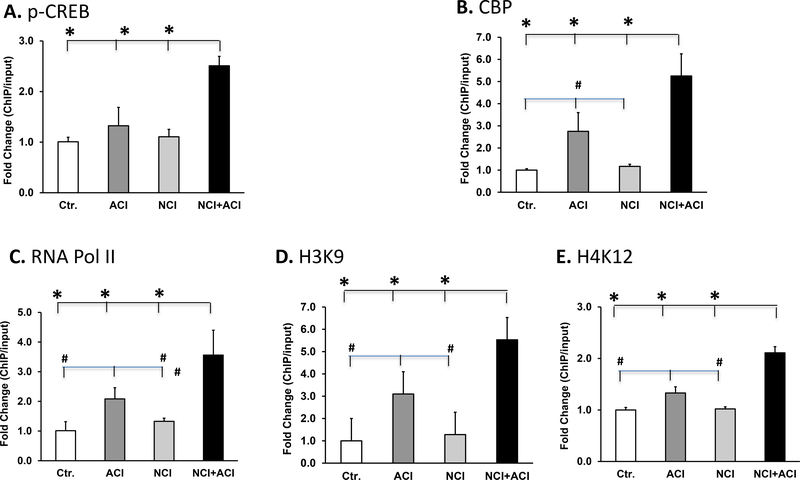Fig. 5.
Bar graphs displaying the results of ChIP assay using chromatin prepared from lumbar/sacral spinal cords. A. Average pCREB binding at the BDNF promoter CRE2 in neonatal/adult inflammation lumbar/sacral spinal cords was significantly greater than in adult colon inflammation (*p<0.001), control (*p<0.001) and neonatal colon inflammation (*p<0.001) rats. We found a significant neonatal colon inflammation x adult colon inflammation interaction F 1,23=30.0, p<0.001, n=5). B. CBP binding at the BDNF promoter CRE2 in neonatal/adult inflammation lumbar/sacral spinal cords was significantly greater than in adult colon inflammation (*p=0.003), control (*p<0.001) and neonatal colon inflammation (*p<0.001) rats; and in adult colon inflammation rats, it was significantly greater than in control (#p=0.021) and neonatal colon inflammation (#p=0.025) rats. (We found a significant neonatal colon inflammation x adult colon inflammation interaction F1,23=6.24, p=0.028, n=5). C. RNA Pol II binding at the BDNF core promoter in neonatal/adult inflammation lumbar/sacral spinal cords was significantly greater vs. that in adult colon inflammation (p=0.03), control (p=0.003) and neonatal colon inflammation (p=0.004); and this binding in adult colon inflammation rats was significantly greater vs. control (#p=0.009) and neonatal colon inflammation (#p=0.012) rats. We found a significant effect of adult colon inflammation (F1,23=13.8, p=0.003} on Pol II binding, n=5). D and E. Both, H3K9 (D) and H4K12 acetylations at the BDNF core promoter in neonatal/adult inflammation lumbar/sacral spinal cords were significantly greater vs. those in adult colon inflammation (*p<0.001), control (*p<0.001) and neonatal colon inflammation (*p<0.001) spinal cord tissues; and both, H3K9 (D) and (E) H4K12 acetylations in adult colon inflammation spinal cord tissues were significantly greater vs. those in control (#p=0.002) and neonatal colon inflammation (#p=0.002) spinal cord tissues. We found a significant interaction between neonatal colon inflammation and adult colon inflammation, F1,23=9.54, p=0.009, n=5).

